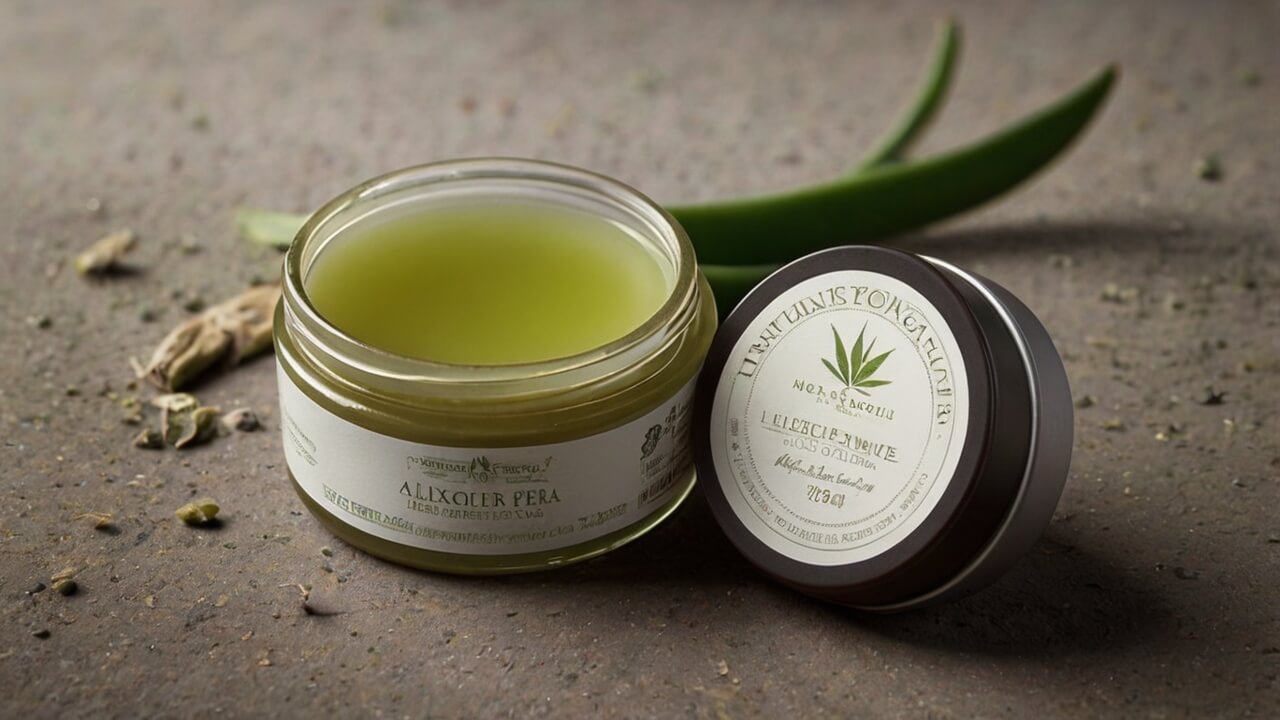An aloe vera salve is a natural, soothing ointment made by infusing the healing properties of aloe vera gel into a base of oils and waxes.
Salves are semi-solid preparations that offer a concentrated and long-lasting application of beneficial ingredients to the skin. Aloe vera, a succulent plant species, has been revered for centuries for its incredible skincare properties.
The clear gel extracted from the plant’s fleshy leaves is rich in vitamins, minerals, antioxidants, and compounds like polysaccharides and glycoproteins that possess remarkable anti-inflammatory, moisturizing, and healing abilities.
When combined with nourishing oils and solidifying agents like beeswax, aloe vera gel transforms into a lush, buttery salve that can be easily applied to the skin.
This concentrated form allows the potent components of aloe to deeply penetrate and work their magic on various skin concerns, such as:
- Sunburns and minor burns: Aloe’s cooling and soothing properties provide relief from pain and inflammation.
- Dry, irritated skin: The gel’s humectant nature deeply hydrates and soothes dry, itchy, or irritated skin.
- Cuts, scrapes, and wounds: Aloe’s antimicrobial and regenerative properties promote faster healing of minor wounds.
- Eczema and psoriasis: The anti-inflammatory compounds help reduce flare-ups and alleviate symptoms.
Making your own aloe vera salve at home allows you to harness the pure, unadulterated goodness of this remarkable plant while customizing the recipe to suit your specific skin needs and preferences.
Benefits of Homemade Aloe Vera Salve
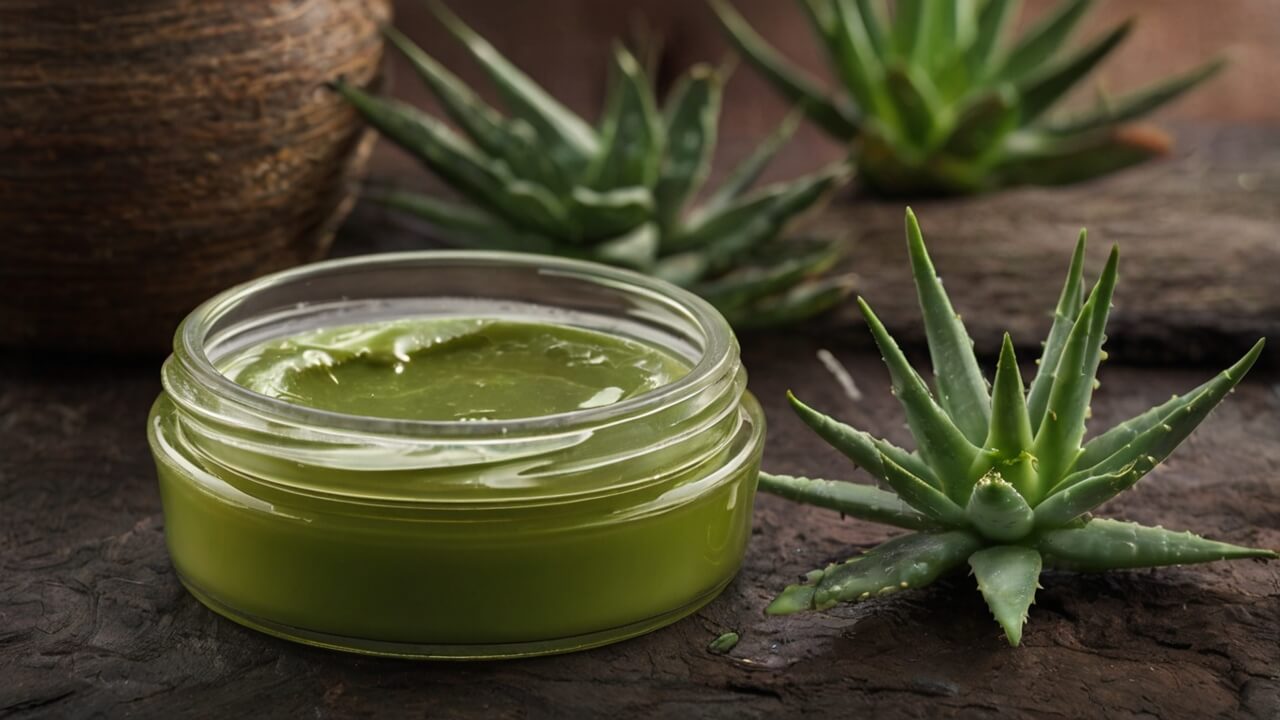
Crafting your own aloe vera salve at home offers numerous advantages over store-bought alternatives. First and foremost, you have complete control over the ingredients, ensuring that your salve is free from harsh chemicals, preservatives, and additives that can potentially irritate sensitive skin.
By using natural and organic components, you can create a gentle, nourishing product tailored to your specific needs.
Homemade alve vera salves are also incredibly cost-effective. The ingredients required, such as aloe vera gel, beeswax, and carrier oils, are relatively inexpensive and readily available.
Making your own salve allows you to enjoy a high-quality, natural skincare product without the premium price tag often associated with commercial alternatives.
One of the greatest advantages of creating your own salve is the ability to customize it to your preferences. You can experiment with different carrier oils, essential oils, and additional ingredients like vitamin E or honey, to create a unique blend that addresses your specific skin concerns.
Whether you desire a soothing, anti-inflammatory salve or a deeply moisturizing balm, the possibilities are endless.
Furthermore, by making your own aloe vera salve, you eliminate the need for excessive packaging and reduce your environmental impact. This simple act of DIY skincare not only benefits your skin but also contributes to a more sustainable lifestyle.
Basic Ingredients and Equipment

To make a nourishing and effective aloe vera salve at home, you’ll need a few key ingredients and some basic equipment. Here’s what you’ll need to gather:
Essential Ingredients:
- Aloe Vera Gel: This is the star ingredient and the base of your salve. You can use fresh aloe vera gel extracted from the leaves or opt for a high-quality, pure aloe vera gel product.
- Beeswax: Beeswax acts as a natural thickener and emulsifier, giving your salve its desired consistency and helping to bind the ingredients together.
- Carrier Oils: Carrier oils help to dilute essential oils (if using) and provide additional nourishing benefits. Popular options include coconut oil, avocado oil, jojoba oil, and olive oil.
Optional Ingredients for Customization:
- Essential Oils: Adding a few drops of your favorite essential oils can enhance the aroma and therapeutic properties of your salve. Popular choices include lavender, tea tree, and peppermint oils.
- Vitamin E Oil: This antioxidant-rich oil helps extend the shelf life of your salve and provides additional skin-nourishing benefits.
- Honey: Known for its antibacterial and moisturizing properties, honey can be a wonderful addition to an aloe vera salve, especially for treating burns or skin irritations.
Necessary Equipment:
- Double boiler or a heat-safe glass bowl and a saucepan
- Spoon or whisk for mixing
- Containers or tins for storing the salve
- Labels and markers (optional)
With these simple ingredients and basic equipment, you’ll be well on your way to creating a customized, natural aloe vera salve tailored to your specific skin care needs.
Method 1: Fresh Aloe Vera Gel and Coconut Oil Salve
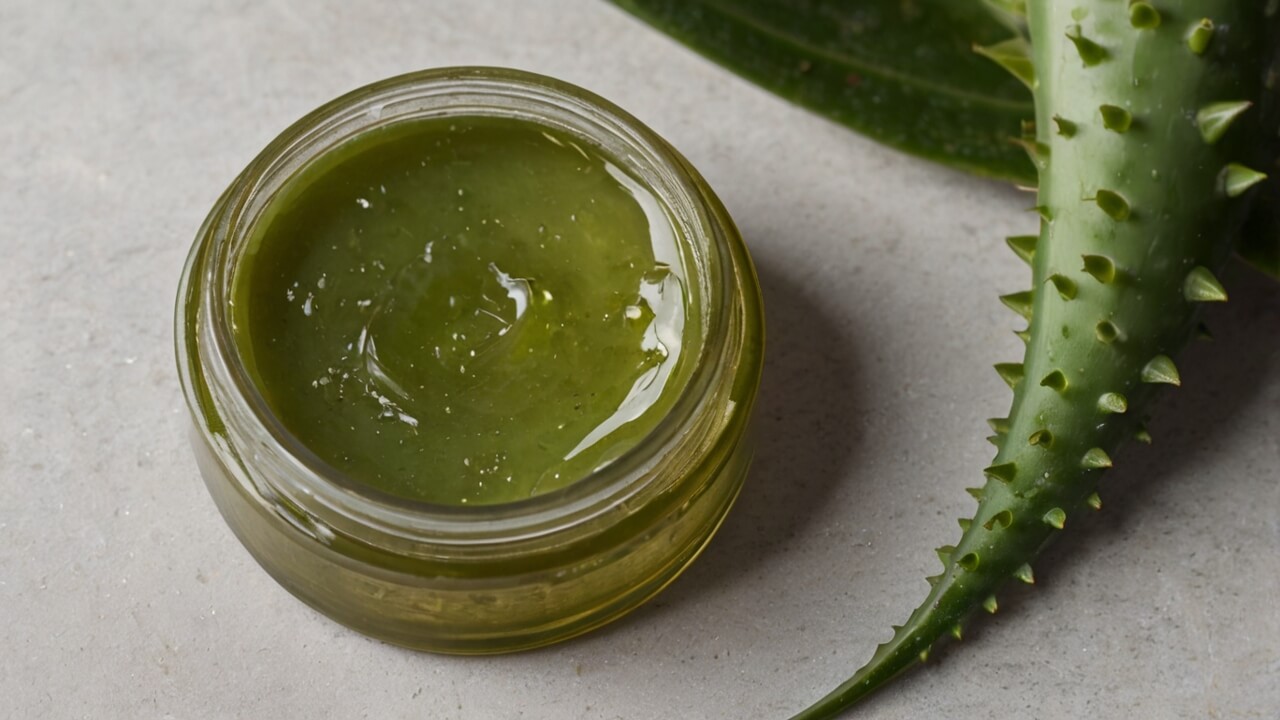
This method uses fresh aloe vera gel straight from the plant, combined with coconut oil to create a soothing, moisturizing salve. Here are the step-by-step instructions:
- Harvest Aloe Vera Gel
- Choose a mature aloe vera leaf and cut it from the plant near the base.
- Using a sharp knife, carefully slice the leaf lengthwise to expose the gel inside.
- Scoop out the clear, thick gel into a bowl, avoiding the green outer rind.
- Measure Ingredients
- Measure out 1/2 cup of fresh aloe vera gel.
- Add 1/4 cup of coconut oil (solid or liquid form).
- Melt the Coconut Oil
- If using solid coconut oil, gently melt it over low heat until liquid.
- Tip: Avoid overheating, as this can diminish the beneficial properties.
- Combine and Mix
- In a double boiler or heat-safe bowl, mix the aloe vera gel and melted coconut oil thoroughly.
- Use an immersion blender or whisk to achieve a smooth, well-incorporated mixture.
- Test Consistency
- At this point, the mixture should have a thick, spreadable consistency.
- If it’s too thick, add a bit more aloe vera gel. If too thin, add more coconut oil.
- Pour and Set
- Carefully pour the warm salve mixture into clean containers or tins.
- Allow the salve to cool completely at room temperature until it solidifies.
Tip: For a smoother texture, you can use an immersion blender to whip the mixture as it cools, creating a light and fluffy consistency.
Once set, your fresh aloe vera and coconut oil salve is ready to use! Gently massage it into the skin as needed for soothing relief and deep hydration.
Method 2: Aloe Vera Powder and Avocado Oil Salve
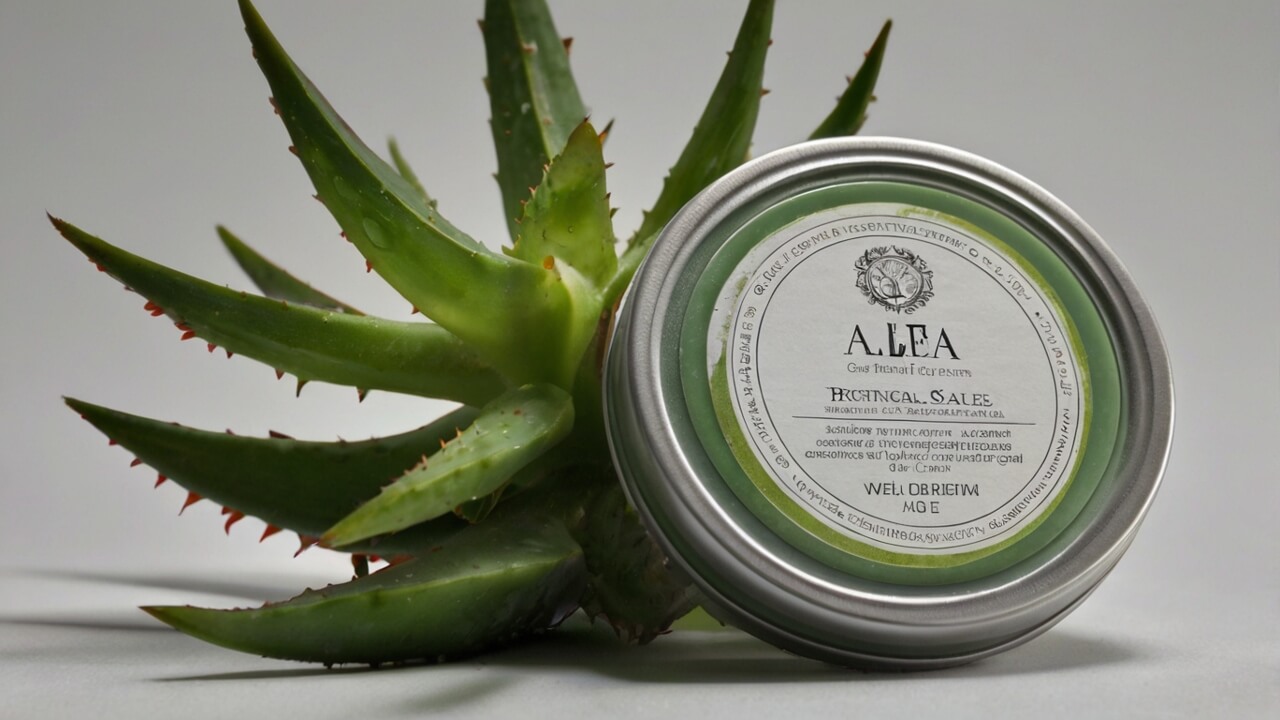
This alternative method uses aloe vera powder instead of fresh aloe gel, allowing you to create a salve without the need for an aloe plant.
The infusion process helps to extract the beneficial properties of the aloe vera into the carrier oil, resulting in a potent and nourishing salve.
Ingredients:
- 1/4 cup aloe vera powder
- 1/2 cup avocado oil
- 1 oz beeswax pastilles or grated beeswax
- 10-15 drops vitamin E oil (optional)
Instructions:
- Infuse the Aloe Vera Powder: In a double boiler or a heat-safe glass bowl placed over a saucepan of simmering water, combine the aloe vera powder and avocado oil. Heat the mixture for about 30 minutes, stirring occasionally. This allows the aloe vera powder to infuse its properties into the oil.
- Strain the Infused Oil: Remove the mixture from heat and strain it through a cheesecloth or a fine mesh strainer to remove any remaining powder particles. Squeeze the cloth or strainer to extract as much infused oil as possible.
- Melt the Beeswax: In a clean double boiler or heat-safe bowl, melt the beeswax over low heat until it becomes liquid.
- Combine the Ingredients: Slowly pour the infused aloe vera oil into the melted beeswax, stirring continuously with a wooden spoon or a whisk. If using vitamin E oil, add it now and mix well.
- Pour and Cool: Carefully pour the mixture into clean containers or tins. Allow the salve to cool completely at room temperature before securing the lids.
The infusion process helps to extract the beneficial compounds from the aloe vera powder, ensuring that the final salve is rich in skin-nourishing properties.
The avocado oil adds extra moisturizing benefits, making this salve an excellent choice for dry or mature skin.
Variation: Lavender Aloe Vera Salve

Adding lavender essential oil to your homemade aloe vera salve can provide additional benefits for your skin. Lavender is renowned for its soothing and calming properties, making it an excellent choice for a relaxing and rejuvenating skincare product.
Benefits of Lavender in Aloe Vera Salve:
- Promotes Relaxation: The calming aroma of lavender can help reduce stress and promote a sense of tranquility, making it ideal for use before bedtime or during moments of tension.
- Soothes Skin Irritations: Lavender possesses anti-inflammatory properties that can help alleviate skin irritations, rashes, and minor burns.
- Improves Sleep Quality: The soothing scent of lavender can aid in promoting better sleep patterns, allowing your body to fully rest and rejuvenate.
- Antibacterial Properties: Lavender has natural antibacterial properties, which can help protect the skin from potential infections.
Lavender Aloe Vera Salve Recipe:
- 1/2 cup aloe vera gel (fresh or store-bought)
- 1/4 cup coconut oil or avocado oil
- 2 tablespoons beeswax pastilles or grated beeswax
- 20-30 drops of lavender essential oil
- 1 teaspoon vitamin E oil (optional)
- Melt the beeswax and coconut/avocado oil together in a double boiler or a heat-safe bowl placed over a saucepan of simmering water. Stir until fully melted and combined.
- Remove the mixture from heat and allow it to cool slightly.
- Add the aloe vera gel, lavender essential oil, and vitamin E oil (if using) to the mixture and whisk vigorously until well incorporated.
- Pour the salve into clean, sterilized containers or tins.
- Allow the salve to cool completely and solidify before securing the lids.
Remember to store your lavender aloe vera salve in a cool, dry place away from direct sunlight. Enjoy the soothing and calming benefits of this natural skincare remedy!
Variation: Honey Burn Salve
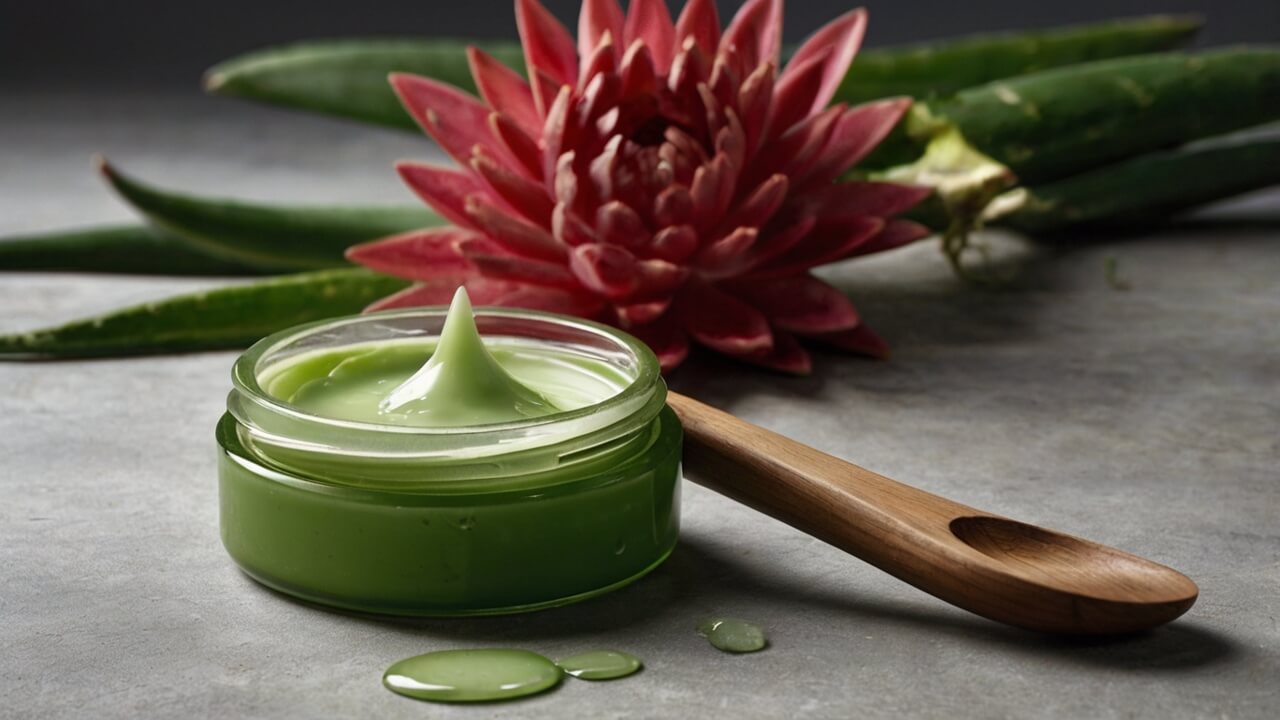
Honey is a natural remedy that has been used for centuries to treat burns and promote healing. Its antibacterial, anti-inflammatory, and moisturizing properties make it an excellent ingredient for a soothing burn salve.
When combined with the cooling and regenerative properties of aloe vera, you get a powerful homemade solution for minor burns, sunburns, and other skin irritations.
The benefits of using a honey burn salve include:
- Antibacterial: Honey has natural antibacterial properties that help prevent infection in burns and wounds.
- Anti-inflammatory: Honey reduces inflammation and swelling, providing relief from the pain and discomfort of burns.
- Moisturizing: Honey is a humectant, meaning it helps retain moisture in the skin, preventing dryness and promoting healing.
- Soothing: The cooling and soothing effects of aloe vera and honey help alleviate the stinging sensation associated with burns.
- Accelerated Healing: Honey and aloe vera work together to promote faster healing of burns and skin regeneration.
To make a honey aloe burn salve, you’ll need the following ingredients:
- 1/2 cup fresh aloe vera gel or 1/4 cup aloe vera powder
- 1/4 cup beeswax pastilles or grated beeswax
- 1/4 cup coconut oil or other carrier oil
- 2-3 tablespoons raw honey
- Optional: 10-15 drops of lavender essential oil for added soothing properties
Follow the basic salve-making method, but add the raw honey during the final stages of cooling, just before pouring the mixture into containers. The honey will blend seamlessly into the salve, creating a nourishing and healing balm for burns, sunburns, and other skin irritations.
Tips for Mixing and Storing Aloe Vera Salve

Proper mixing and storage techniques are crucial to ensure the effectiveness and longevity of your homemade aloe vera salve. Here are some best practices to follow:
Mixing Tips:
- Use a double boiler or a heat-safe bowl placed over a saucepan of simmering water to gently melt the beeswax and oils together. Direct heat can cause the ingredients to burn or degrade.
- Stir the mixture continuously with a wooden spoon or spatula to prevent scorching and ensure even melting.
- Once the beeswax and oils are fully melted, remove the mixture from heat and allow it to cool slightly before adding the aloe vera gel or infused oil. This prevents the aloe from losing its beneficial properties due to excessive heat.
- For a smoother texture, blend the mixture using an immersion blender or whisk vigorously until well combined.
Storage Tips:
- Once the salve has cooled to room temperature, transfer it into sterilized, airtight containers, such as glass jars or tins. Avoid using plastic containers, as they can react with the oils and affect the salve’s quality.
- Store the salve in a cool, dark place, away from direct sunlight and heat sources. Excessive heat or light exposure can degrade the salve’s potency and shelf life.
- For optimal freshness, use the salve within 6 to 12 months. Properly stored aloe vera salve can last up to a year.
- To check for spoilage, look for signs of discoloration, separation, or an off odor. If any of these are present, discard the salve.
By following these tips, you can ensure that your homemade aloe vera salve retains its nourishing properties and stays fresh for an extended period, allowing you to enjoy its skin-soothing benefits for months to come.
Customize Your Aloe Salve
The beauty of making your own aloe vera salve lies in the ability to customize it according to your specific needs and preferences.
While the base recipes provided offer excellent all-purpose salves, you can elevate them further by incorporating additional ingredients tailored to your skin concerns or desired scents.
For Dry Skin: If you struggle with dry, flaky skin, consider adding a few drops of nourishing plant oils like argan oil, rosehip seed oil, or sea buckthorn oil to your aloe salve. These oils are rich in fatty acids and vitamins that deeply hydrate and replenish the skin.
For Mature Skin: To address the signs of aging, such as fine lines and wrinkles, try infusing your salve with carrot seed oil or frankincense essential oil. Both are known for their ability to promote skin elasticity and a youthful glow.
For Acne-Prone Skin: Those with acne-prone or oily skin can benefit from the addition of tea tree essential oil or neem oil, which have natural antibacterial and sebum-regulating properties.
For Soothing Irritation: If you’re dealing with skin irritation, redness, or inflammation, consider incorporating calendula oil, chamomile essential oil, or almond oil into your aloe salve. These ingredients are renowned for their calming and soothing effects.
For Scent and Aromatherapy: To create a truly indulgent experience, you can add your favorite essential oils to your aloe salve. Some popular choices include lavender, rose, jasmine, or ylang-ylang for their relaxing and uplifting aromas.
Remember, when adding essential oils or other potent ingredients, it’s crucial to use them sparingly and follow the recommended dilution rates to avoid any potential skin irritation. Start with a small amount and gradually increase until you achieve the desired effect.
Conclusion
Making your own aloe vera salve at home is a rewarding and cost-effective way to create a versatile, natural skincare product.
By following the recipes and methods outlined in this guide, you can harness the soothing and healing properties of aloe vera, combined with nourishing carrier oils and beneficial additives like vitamin E and honey.
The beauty of homemade salves lies in their customizability. Don’t be afraid to experiment with different essential oils, herbs, or ingredients to tailor the salve to your specific skin needs or preferences.
The possibilities are endless, and the process of crafting your own personal blend can be a therapeutic and empowering experience.
We encourage you to try the recipes provided and share your experiences in the comments below. Did you find a unique combination that worked wonders for your skin?
Or perhaps you have a family recipe that has been passed down through generations? We’d love to hear about your journey and learn from your insights.
To stay updated with more DIY skincare tips, recipes, and natural remedies, we invite you to subscribe to our newsletter. Join our community of like-minded individuals who prioritize natural, sustainable, and holistic approaches to self-care.
Embrace the power of nature and take control of your skincare routine with a homemade aloe vera salve.
Your skin will thank you for the nourishing, gentle care, and you’ll experience the satisfaction of creating something truly special with your own hands.

